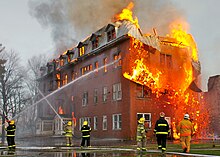Building
This articleneeds additional citations forverification.(October 2023) |
Abuildingoredificeis an enclosedstructurewith aroofandwalls,usually standing permanently in one place,[1]such as ahouseorfactory.[1]Buildings come in a variety ofsizes,shapes,and functions, and have been adapted throughout history for numerous factors, frombuilding materialsavailable, to weather conditions, land prices, ground conditions, specific uses,prestige,and aesthetic reasons. To better understand the concept, seeNonbuilding structurefor contrast.
Buildings serve several societal needs –occupancy,primarily as shelter from weather, security, living space, privacy, to store belongings, and to comfortably live and work. A building as a shelter represents a physical separation of thehuman habitat(a place of comfort and safety) from theoutside(a place that may be harsh and harmful at times).
Ever since the firstcave paintings,buildings have been objects or canvasses of muchartistic expression.In recent years, interest insustainable planningandbuilding practiceshas become an intentional part of thedesign processof manynew buildingsand other structures, usuallygreen buildings.
Definition
[edit]
A building is 'a structure that has a roof and walls and stands more or less permanently in one place';[1]"there was a three-storey building on the corner"; "it was an imposing edifice". In the broadest interpretation afenceor wall is a building.[2]However, the wordstructureis used more broadly thanbuilding,to include natural and human-made formations[3]and ones that do not have walls;structureis more often used for a fence.Sturgis' Dictionaryincluded that"[building]differs fromarchitecturein excluding all idea of artistic treatment; and it differs fromconstructionin the idea of excluding scientific or highly skilful treatment. "[4]
Structural heightin technical usage is the height to the highest architectural detail on the building from street level. Spires and masts may or may not be included in this height, depending on how they are classified. Spires and masts used as antennas are not generally included. The distinction between a low-rise and high-rise building is a matter of debate, but generally three stories or less is considered low-rise.[5]
History
[edit]There is clear evidence of homebuilding from around 18,000 BC.[6]Buildings became common during theNeolithic period.[7]
Types
[edit]


Residential
[edit]Single-family residential buildings are most often calledhousesorhomes.Multi-family residential buildings containing more than one dwelling unit are calledduplexesorapartment buildings.Condominiumsare apartments that occupantsownrather thanrent.Houses may be built in pairs (semi-detached) or in terraces, where all but two of the houses have others on either side. Apartments may be built roundcourtyardsor as rectangular blocks surrounded by plots of ground. Houses built as single dwellings may later be divided into apartments orbedsitters,or converted to other uses (e.g., offices or shops).Hotels,especially of the extended-stay variety (apartels), can be classed as residential.
Building types may range fromhutsto multimillion-dollarhigh-riseapartment blocksable to house thousands of people. Increasing settlement density in buildings (and smaller distances between buildings) is usually a response to high ground prices resulting from the desire of many people to live close to their places of employment or similar attractors.
Terms for residential buildings reflect such characteristics asfunction(e.g.,holiday cottage(vacation home) ortimeshareif occupied seasonally);size(cottageorgreat house);value(shackormansion);manner of construction(log homeormobile home);architectural style(castleorVictorian); andproximity to geographical features(earth shelter,stilt house,houseboat,or floating home). For residents in need of special care, or those society considers dangerous enough to deprive ofliberty,there areinstitutions(nursing homes,orphanages,psychiatric hospitals,andprisons) and group housing (barracksanddormitories).
Historically, many people lived in communal buildings calledlonghouses,smaller dwellings calledpit-houses,and houses combined with barns, sometimes calledhousebarns.
Commonbuilding materialsinclude brick, concrete, stone, and combinations thereof. Buildings are defined to be substantial, permanent structures. Such forms asyurtsandmotorhomesare therefore considereddwellingsbut notbuildings.
Commercial
[edit]A commercial building is one in which at least onebusinessis based and people do not live. Examples includestores,restaurant,andhotels.[citation needed]
Industrial
[edit]Industrial buildings are those in whichheavy industryis done, such asmanufacturing.These edifices includewarehousesandfactories.[citation needed]
Agricultural
[edit]Agricultural buildings are theoutbuildings,such asbarnslocated onfarms.[citation needed]
Mixed use
[edit]Some buildings incorporate several or multiple different uses, most commonly commercial and residential.[citation needed]
Complex
[edit]
Sometimes a group of inter-related (and possibly inter-connected) builds are referred to as a complex – for example ahousing complex,[8]educational complex,[9]hospital complex, etc.
Creation
[edit]The practice of designing, constructing, and operating buildings is most usually a collective effort of different groups ofprofessionalsandtrades.Depending on the size, complexity, and purpose of a particular building project, the project team may include:
- Areal estate developerwho securesfundingfor the project;
- One or more financial institutions or other investors that provide the funding
- Local planning and code authorities
- Asurveyorwho performs an ALTA/ACSM and construction surveys throughout the project;
- Construction managerswho coordinate the effort of different groups of project participants;
- Licensedarchitectsandengineerswho providebuilding designand prepareconstruction documents;
- The principal design Engineering disciplines which would normally include the following professionals:Civil,Structural,Mechanicalbuilding services or HVAC (heating Ventilation and Air Conditioning) Electrical Building Services, Plumbing and drainage. Also other possible design Engineer specialists may be involved such as Fire (prevention), Acoustic, façade engineers, building physics, Telecoms, AV (Audio Visual), BMS (Building Management Systems) Automatic controls etc. These design Engineers also prepare construction documents which are issued to specialist contractors to obtain a price for the works and to follow for the installations.
- Landscape architects;
- Interior designers;
- Other consultants;
- Contractorswho provideconstructionservices and install building systems such asclimate control,electrical,plumbing,decoration,fire protection,securityandtelecommunications;
- Marketing orleasingagents;
- Facility managerswho are responsible for operating the building.
Regardless of their size or intended use, all buildings in the US must comply withzoning ordinances,building codesand other regulations such asfire codes,life safety codesand related standards.
Vehicles—such astrailers,caravans,shipsand passengeraircraft—are treated as "buildings" for life safety purposes.
Ownership and funding
[edit]Environmental impacts
[edit]Buildings represent a large part of energy, electricity, water and materials consumption. As of 2020, they account for 37% of global energy use and energy-related CO2emissions, which the United Nations estimate contributed to 33% of overall worldwide emissions.[10][11]Including the manufacturing of building materials, the global CO2emissions were 39%.[12]If new technologies in construction are not adopted during this time of rapid growth, emissions could double by 2050, according to theUnited Nations Environment Program.
Glass buildings, especially all-glass skyscrapers, contribute significantly to climate change due to their energy inefficiency. While these structures are visually appealing and allow abundant natural light, they also trap heat, necessitating increased use of air conditioning systems, which contribute to higher carbon emissions. Experts advocate for design modifications and potential restrictions on all-glass edifices to mitigate their detrimental environmental impact.[13][14]
Buildings account for a large amount of land. According to theNational Resources Inventory,approximately 107 million acres (430,000 km2) of land in the United States are developed. TheInternational Energy Agencyreleased a publication that estimated that existing buildings are responsible for more than 40% of the world's total primary energy consumption and for 24% of global carbon dioxide emissions.[15][16]
According to Global status report from the year 2016, buildings consume more than 30% of all produced energy. The report states that "Under a below 2°C trajectory, effective action to improve buildingenergy efficiencycould limit building final energy demand to just above current levels, meaning that the average energy intensity of the global building stock would decrease by more than 80% by 2050 ".[17]
Building services
[edit]Physical plant
[edit]
Any building requires a certain general amount of internal infrastructure to function, which includes such elements like heating / cooling, power and telecommunications, water and wastewater etc. Especially incommercial buildings(such as offices or factories), these can be extremely intricate systems taking up large amounts of space (sometimes located in separate areas or double floors / false ceilings) and constitute a big part of the regular maintenance required.
Conveying systems
[edit]Systems fortransportof people within buildings:
- Elevator

An under construction building in Pune, India. It is a high rise building, located in the South-Eastern Part of the city. In an area commonly known as 'Nine Hills'. - Escalator
- Moving sidewalk(horizontal and inclined)
Systems for transport of people between interconnected buildings:
Building damage
[edit]
Buildings may be damaged during construction or during maintenance. They may be damaged by accidents[20]involving storms, explosions, subsidence caused by mining,[21]water withdrawal[22]or poor foundations[23]and landslides.[24]Buildings may sufferfire damage[25][26]and flooding.[27]They may become dilapidated through lack of proper maintenance, or alteration work improperly carried out.
See also
[edit]References
[edit]- ^abcMax J. Egenhofer (2002).Geographic Information Science: Second International Conference, GIScience 2002, Boulder, CO, USA, September 25–28, 2002. Proceedings.Springer Science & Business Media. p. 110.ISBN978-3-540-44253-0.
- ^Building def. 2. Whitney, William Dwight, and Benjamin E. Smith.The Century dictionary and cyclopedia.vol. 1. New York: Century Co., 1901. 712. Print.
- ^Structure. def. 2.Merriam-Webster's dictionary of synonyms: a dictionary of discriminated synonyms with antonyms and analogous and contrasted words.. Springfield, Mass: Merriam-Webster, 1984. 787. Print.
- ^Building. def 1. Sturgis, Russell.A dictionary of architecture and building: biographical, historical, and descriptive.vol. 1. New York: The Macmillan Co.; 1901. 2236. Print.
- ^Paul Francis Wendt and Alan Robert Cerf (1979),Real estate investment analysis and taxation,McGraw-Hill, p. 210
- ^Rob Dunn(Aug 23, 2014)."Meet the lodgers: Wildlife in the great indoors".New Scientist:34–37.Archivedfrom the original on 2014-11-29.
- ^Pace, Anthony (2004). "Tarxien". In Daniel Cilia (ed.).Malta before History – The World's Oldest Free Standing Stone Architecture.Miranda Publishers.ISBN978-9990985085.
- ^"plans to convert housing complex".Archived fromthe originalon 2017-01-10.Retrieved2017-02-23.
- ^"isye building complex".Archivedfrom the original on 2017-01-03.
- ^"2020 Global Status Report for Buildings and Construction: Towards a Zero-emissions, Efficient and Resilient Buildings and Construction Sector - Executive Summary".2020.
- ^Nord, Natasa (2017),"Building Energy Efficiency in Cold Climates",Encyclopedia of Sustainable Technologies,Elsevier, pp. 149–157,doi:10.1016/b978-0-12-409548-9.10190-3,ISBN978-0-12-804792-7,retrieved2022-04-04
- ^Global Alliance for Buildings and Construction; International Energy Agency; United Nations Environment Programme (2019)."2019 Global Status Report for Buildings and Construction Towards a zero-emissions, efficient, and resilient buildings and construction sector"(PDF).UN environment programme Document Repository.United Nations Environment Programme.Archived(PDF)from the original on 21 October 2020.Retrieved20 October2020.
- ^Tapper, James (Jul 28, 2019)."Experts call for ban on glass skyscrapers to save energy in climate crisis".The Guardian.Archived fromthe originalon July 28, 2019.RetrievedSep 7,2023.
- ^"Wasteful steel-and-glass buildings fuel global climate injustice, says climate expert".phys.org.Oct 19, 2019. Archived fromthe originalon October 19, 2021.RetrievedSep 7,2021.
- ^"Buildings – Analysis".
- ^Goodhew S 2016 Sustainable Construction Processes A Resource Text. John Wiley & Son
- ^Towards zero-emission efficient and resilient buildings GLOBAL STATUS REPORT 2016(PDF).Global Alliance for Buildings and construction. 2016. p. 8.Retrieved1 April2022.
- ^Watson, Donald (2013), Loftness, Vivian; Haase, Dagmar (eds.),"Bioclimatic Designbioclimaticdesign",Sustainable Built Environments,New York, NY: Springer, pp. 1–30,doi:10.1007/978-1-4614-5828-9_225,ISBN978-1-4614-5828-9,retrieved2023-07-12
- ^"Bioclimatic architecture, buildings that respect the environment".Iberdrola.Retrieved2022-04-03.
- ^"Building Damage".Pb.unimelb.edu.au. Archived fromthe originalon 2014-02-14.Retrieved2014-08-22.
- ^Herrera, G.; Álvarez Fernández, M.I.; Tomás, R.; González-Nicieza, C.; López-Sánchez, J.M.; Álvarez Vigil, A.E. (September 2012)."Forensic analysis of buildings affected by mining subsidence based on Differential Interferometry (Part III)".Engineering Failure Analysis.24:67–76.doi:10.1016/j.engfailanal.2012.03.003.hdl:20.500.12468/749.
- ^Bru, G.; Herrera, G.; Tomás, R.; Duro, J.; Vega, R. De la; Mulas, J. (2013-02-01). "Control of deformation of buildings affected by subsidence using persistent scatterer interferometry".Structure and Infrastructure Engineering.9(2): 188–200.doi:10.1080/15732479.2010.519710.ISSN1573-2479.S2CID110521863.
- ^Díaz, E.; Robles, P.; Tomás, R. (October 2018)."Multitechnical approach for damage assessment and reinforcement of buildings located on subsiding areas: Study case of a 7-story RC building in Murcia (SE Spain)".Engineering Structures.173:744–757.Bibcode:2018EngSt.173..744D.doi:10.1016/j.engstruct.2018.07.031.hdl:10045/77547.
- ^Soldato, Matteo Del; Bianchini, Silvia; Calcaterra, Domenico; Vita, Pantaleone De; Martire, Diego Di; Tomás, Roberto; Casagli, Nicola (2017-07-12)."A new approach for landslide-induced damage assessment"(PDF).Geomatics, Natural Hazards and Risk.8(2): 1524–1537.Bibcode:2017GNHR....8.1524D.doi:10.1080/19475705.2017.1347896.ISSN1947-5705.S2CID73697187.
- ^Brotóns, V.; Tomás, R.; Ivorra, S.; Alarcón, J. C. (2013-12-17). "Temperature influence on the physical and mechanical properties of a porous rock: San Julian's calcarenite".Engineering Geology.167(Supplement C): 117–127.Bibcode:2013EngGe.167..117B.doi:10.1016/j.enggeo.2013.10.012.
- ^Tomás, R.; Cano, M.; Pulgarín, L.F.; Brotóns, V.; Benavente, D.; Miranda, T.; Vasconcelos, G. (November 2021)."Thermal effect of high temperatures on the physical and mechanical properties of a granite used in UNESCO World Heritage sites in north Portugal".Journal of Building Engineering.43:102823.doi:10.1016/j.jobe.2021.102823.hdl:10045/115630.
- ^Marvi, Morteza T. (2020-07-01)."A review of flood damage analysis for a building structure and contents".Natural Hazards.102(3): 967–995.Bibcode:2020NatHa.102..967M.doi:10.1007/s11069-020-03941-w.ISSN1573-0840.


















